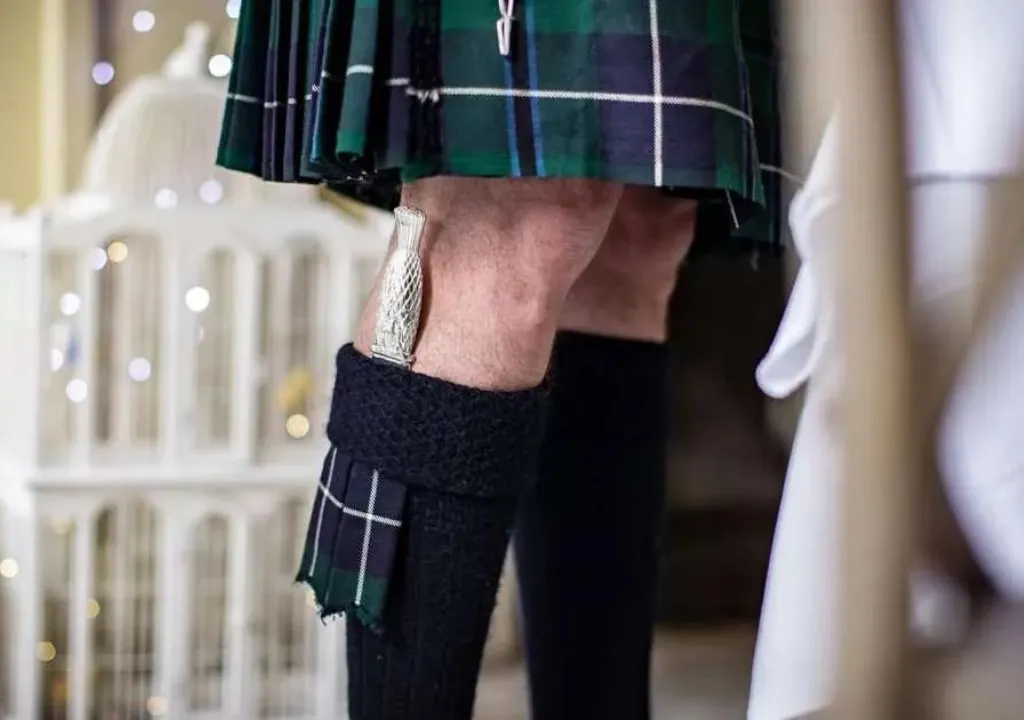What is a Sgian Dubh? How to Choose the Perfect One

The Sgian Dubh is a small, traditional Scottish knife that plays a significant role in kilt accessories, particularly as part of the Highland dress. Worn tucked into the kilt hose with only the hilt visible, the Sgian Dubh is both a ceremonial and symbolic accessory, embodying centuries of history and tradition.
Originally a utility knife used for everyday tasks, the Sgian Dubh has evolved into a meaningful element of Scottish attire, symbolizing the wearer's connection to their heritage. The name "Sgian Dubh," meaning "black knife" in Gaelic, may refer to its concealed nature or the dark materials traditionally used for the handle.
Today, it is often worn during formal occasions such as weddings, Highland games, and other cultural events.Choosing the perfect Sgian Dubh involves understanding its history, appreciating its cultural significance, and considering factors like craftsmanship, materials, and personal style.
Whether you're honoring your Scottish roots or appreciate fine craftsmanship, the Sgian Dubh remains a timeless and essential part of Scottish tradition, making it a must-have for anyone participating in or celebrating Scottish heritage.
Understanding the History of the Sgian Dubh
The Sgian Dubh (pronounced "Skeen Doo") has its origins deeply rooted in Scottish history from then its a accesntial part of kilt accessories. The term itself translates to "black knife," with "Sgian" meaning knife and "Dubh" meaning black in Gaelic.
This small knife was traditionally carried hidden, hence the "black" in its name, possibly referring to its concealed nature or the color of its handle.Historically, the Sgian Dubh was a utility knife used for daily tasks such as cutting food, hunting, or even self-defense.
Over time, it evolved from a practical tool into a ceremonial accessory, becoming an integral part of the Scottish Highland dress. Today, the Sgian Dubh is often worn and tucked into the top of the kilt hose, with only the hilt visible, symbolizing readiness and respect.
Choosing the Perfect Sgian Dubh
When choosing the perfect Sgian Dubh, several factors should be taken into consideration:
- Purpose: Consider whether you need a Sgian Dubh for formal occasions, casual wear, or as a collectible item. This will influence the style, material, and price range.
- Budget: Sgian Dubhs can include affordable luxury items. Set a budget before you start shopping, and look for the best quality within your price range.
- Authenticity: If tradition is important to you, opt for a Sgian Dubh made from traditional materials by a skilled craftsman. Authentic Sgian Dubhs often come with a certificate of authenticity.
- Comfort: Ensure the Sgian Dubh is comfortable to wear. Check that it fits securely in your kilt hose and is not too heavy.
- Design: Choose a design that resonates with you. Whether it's a traditional Sgian Dubh with Celtic engravings or a modern version with a sleek design, it should reflect your style and heritage.
The Symbolism and Cultural Significance of the Sgian Dubh
The Sgian Dubh is more than just a knife; it is a symbol of Scottish heritage and identity. It carries with it a sense of tradition, loyalty, and respect for one's ancestry. The act of wearing the Sgian Dubh in the open rather than concealed reflects a gesture of peace, indicating that the wearer carries no hidden weapons.
This small knife is also symbolic of the wearer's connection to their Scottish roots. For many, wearing a Sgian Dubh during formal events such as weddings, ceilidhs (traditional Scottish gatherings), or Highland games is a way to honor and preserve their cultural heritage.
Anatomy of a Sgian Dubh: Key Components
To choose the perfect Sgian Dubh, it's essential to understand its anatomy. The Sgian Dubh is typically composed of several key components:
- Blade: The blade is usually about 3-4 inches long and can be made from various materials, including stainless steel or carbon steel. It is often single-edged and pointed and designed for both practical and ceremonial use.
- Handle: Traditionally, the handle is made from materials such as bog oak, wood, or horn. Modern versions may also feature handles made from synthetic materials or even jewels and precious metals.
- Sheath: The sheath, often crafted from leather or metal, is designed to protect the blade and the wearer. It may be decorated with Celtic patterns, clan crests, or other symbols of Scottish heritage.
- Pommel: The pommel at the end of the handle is often ornate, featuring designs like Celtic knots, thistles, or jewels. In some cases, it may also have a stone or gem embedded in it, adding a personal touch to the knife.
Materials and Craftsmanship: What to Look For
When selecting a Sgian Dubh, the quality of materials and craftsmanship is paramount. Here are some key aspects to consider:
- Blade Material: Look for blades made from high-quality stainless steel or carbon steel. Stainless steel offers durability and resistance to corrosion. In contrast, carbon steel can hold a sharper edge but requires more maintenance to prevent rust.
- Handle Material: Traditional materials like bog oak or antler not only add authenticity but also durability. Synthetic materials may offer a more affordable option but can lack the traditional feel.
- Craftsmanship: A well-crafted Sgian Dubh will feature a balance between the blade and handle, with attention to detail in the carving, engraving, or embellishments. Handmade Sgian Dubhs often offer superior quality compared to mass-produced ones, reflecting the skill and tradition of the craftsman.
Types of Sgian Dubh: From Traditional to Modern Designs
The Sgian Dubh comes in various styles, ranging from traditional to more contemporary designs:
- Traditional Sgian Dubh: These often feature handles made from natural materials like bog oak, ebony, or antler and are adorned with Celtic engravings or clan crests. The blade is usually simple and functional.
- Modern Sgian Dubh: Modern versions may incorporate synthetic materials, colored stones, or jewels. Some modern designs even include a safety blade, making them more suitable for events with strict security measures.
- Dress Sgian Dubh: Specifically designed for formal occasions; these often feature ornate handles with gemstones, silver or gold accents, and intricate engravings.
- Casual Sgian Dubh: Designed for everyday wear or less formal occasions, these are often simpler in design and made of durable materials suited for regular use.
How to Wear a Sgian Dubh Correctly
Wearing the Sgian Dubh correctly is an important aspect of Highland dress etiquette. Here's a step-by-step guide:
- Placement: The Sgian Dubh is traditionally worn on the same side as your dominant hand, tucked into the top of your kilt hose (sock). The hilt should be visible just above the sock.
- Angle: Ensure the Sgian Dubh is angled slightly towards your leg, making it secure and easy to reach if needed.
- Visibility: Only the handle should be visible, with the rest of the knife concealed within the hose. This represents a gesture of goodwill and openness.
- Formality: For formal occasions, a more ornate Sgian Dubh may be appropriate, whereas a simpler design may suit casual events.
- Customization: Personalizing Your Sgian Dubh
One of the most appealing aspects of the Sgian Dubh is the ability to customize it to reflect personal tastes or family heritage. Some common ways to personalize a Sgian Dubh include:
- Clan Crests: Many opt to have their family's clan crest engraved on the handle or sheath, making it a personal and meaningful accessory.
- Initials or Name: Engraving your initials or name on the Sgian Dubh adds a personal touch, making it uniquely yours.
- Gemstones: Some prefer to add gemstones to the pommel, often selecting a stone that holds personal significance, such as a birthstone.
- Custom Engravings: Whether it's a Celtic knot, a favorite quote, or a significant date, custom engravings can make your Sgian Dubh truly one-of-a-kind.
Legal Considerations: Owning and Carrying a Sgian Dubh
While the Sgian Dubh is a traditional accessory, it is still a knife, and there are legal considerations to be aware of, depending on your location:
- Public Carrying: In some countries, carrying a knife in public can be illegal unless it is for a recognized cultural or religious purpose. Always check local laws before wearing a Sgian Dubh in public.
- Airport Security: When traveling, particularly by air, it's important to remember that a Sgian Dubh may be considered a weapon and thus not allowed in carry-on luggage. It's advisable to pack it in checked baggage or, if possible, avoid bringing it together.
- Event Restrictions: Some venues or events may restrict the carrying of knives, even ceremonial ones. Always check the event's policy in advance.
- Caring for Your Sgian Dubh: Maintenance Tips
Proper care is essential to maintain the quality and appearance of your Sgian Dubh. Here are some tips:
- Cleaning: After each use, especially if the blade comes into contact with moisture or food, clean the blade with a soft cloth and a mild cleaner. Avoid using abrasive materials that could scratch the blade.
- Sharpening: Keep the blade sharp by regularly honing it with a sharpening stone or steel. If you need more confidence in sharpening it yourself, consider having it professionally done.
- Storage: Store your Sgian Dubh in a dry place, ideally in its sheath, to protect the blade from dust and moisture. Avoid storing it in humid environments to prevent rust, especially if the blade is made from carbon steel.
- Handle Care: If your Sgian Dubh has a wooden or horn handle, occasionally treat it with a small amount of oil to keep it from drying out and cracking.
Conclusion:
The Sgian Dubh is more than just a knife; it is a symbol of Scottish heritageand a part of kilt accessories, a piece of history, and a functional accessory that has stood the test of time. Whether you are a Scot looking to connect with your roots or appreciate craftsmanship and tradition, choosing the perfect Sgian Dubh requires careful consideration of its history, materials, and design. By following this guide, you can select a Sgian Dubh that not only complements your Highland attire but also carries with it the pride and legacy of Scotland.
FAQs
The Sgian dubh should be worn on the dominant leg. Traditionally, it is worn on the right leg if you are right-handed.
Yes, you can wear a real Sgian dubh, but it must be worn in a sheath and not visible. It is typically carried as part of traditional Scottish dress, often with the blade concealed for safety.
Yes, you can sharpen a Sgian dubh, but it’s important to do so carefully and responsibly. Many modern Sgian dubhs are designed as decorative pieces, so if it’s for display, keeping it blunt may be preferable
The knife traditionally worn in a Scotsman’s sock is called a “sgian-dubh” (pronounced skee-an doo). It’s a small, single-edged knife, often with a decorative handle, and it’s part of traditional Scottish Highland dress.


